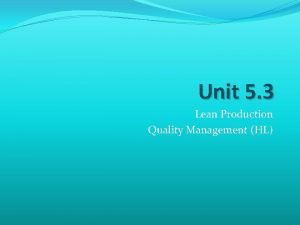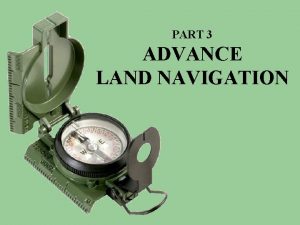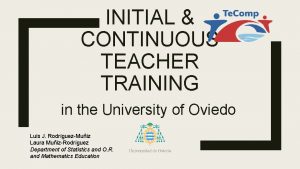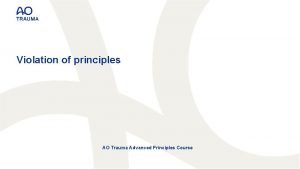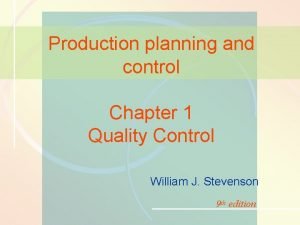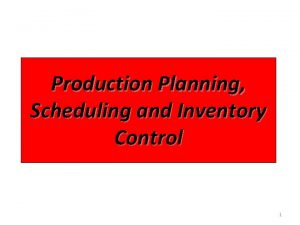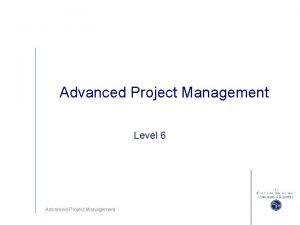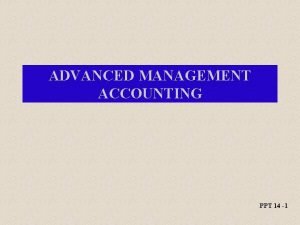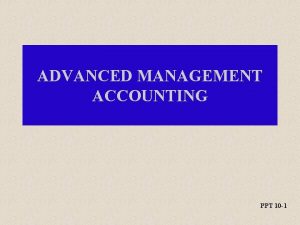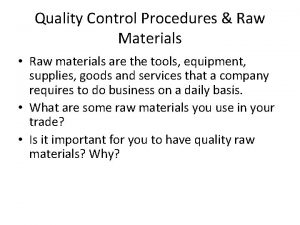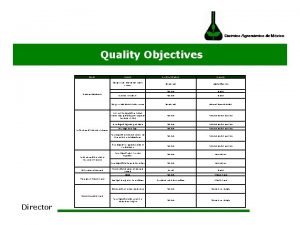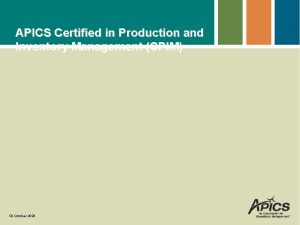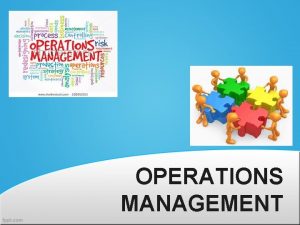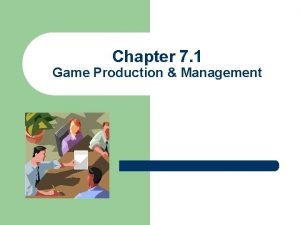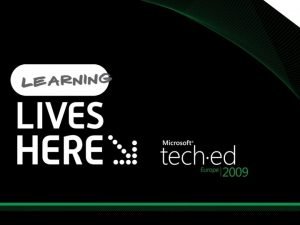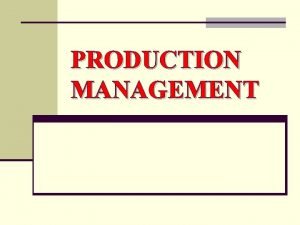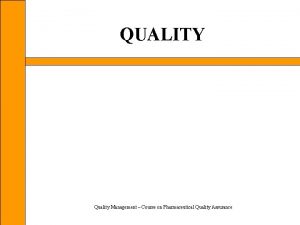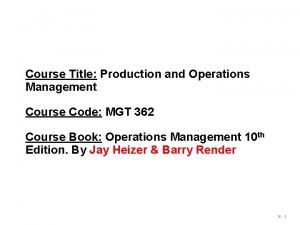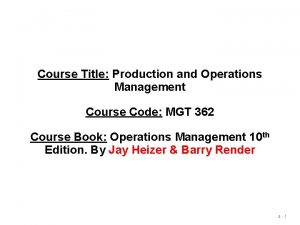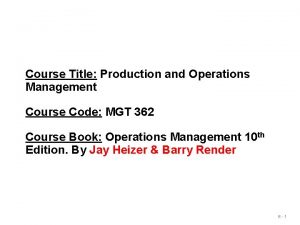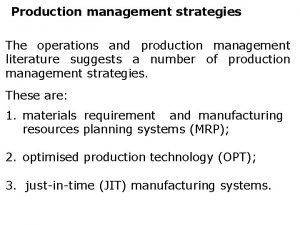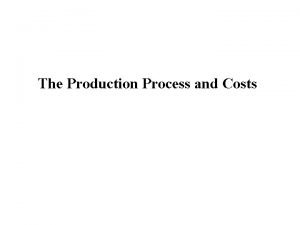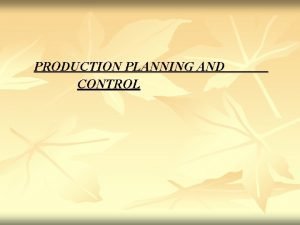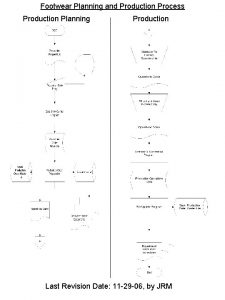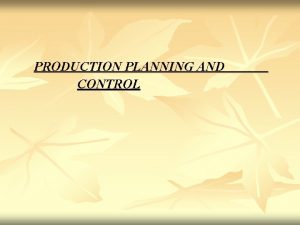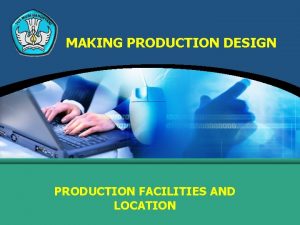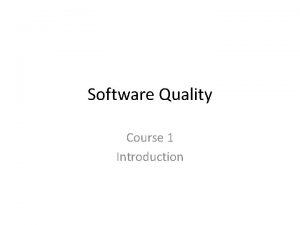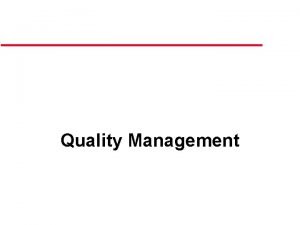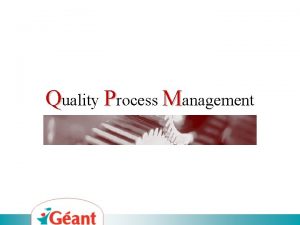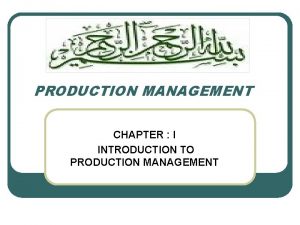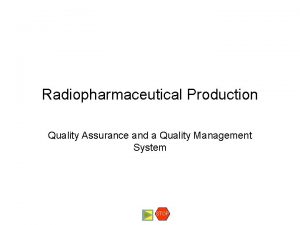Advanced Production and Quality Management Course n Quality





























- Slides: 29

Advanced Production and Quality Management Course n Quality Function n Deployment (QFD) n CDR Ric Schulz

What’s in a Name? HIN SHITSU n Quality Attributes Features KI NO Function TEN KAI Deployment Development Evolution “Customer Driven Product/Process Development” “The House of Quality” “The Voice of the Customer”

Purpose of QFD n 1. Prioritize spoken and unspoken customer wows, wants, and needs. n 2. Translate these needs into technical characteristics and specifications. n 3. Build and deliver a quality product or service by focusing everybody toward customer satisfaction.

Origins of QFD n Introduced in 1966 by Yoji Akao n First structured use attributed to the Kobe Shipyard of Mitsubishi Heavy Industries, Ltd in 1972 n Introduced to US in 1983 article in Quality Press, an ASQC publication n Leaders in applying QFD in Japan include; Akao, Macabe and Fukahara

QFD in North America n Recently been introduced in North America n n n Ford uses it in transmission assembly plant Proctor and Gamble developed Luvs Disposable Diapers and the Crest Complete Toothbrush Chrysler developed vehicles such as the NEON n In 1984 companies began considering QFD for software development

What is Quality Function Deployment? • QFD is a bad name for a great tool!!!!! • QFD is a lot of common sense wrapped up in a very structured process. • QFD keeps the Customer Focus. • QFD is efficient – it uses the 80/20 approach (80% benefit w/ 20% effort). • QFD improves the Integrated Product and Process Development (IPPD) system. The Ultimate benefit of QFD is a timely delivery of a product or service that meets or exceeds the customers expectations

QFD Results Proactive Development Process Design Changes Japanese Companies U. S. Companies Traditional Development Curve Re-design “Hump” Production Start Date 90% Changes Complete 20 -24 14 -17 1 -3 MONTHS Job #1 +3 Note: Area under curves represent the Cost of Developing/Deploying a Product!

Top 10 Reasons When QFD is Appropriate……… 1. 2. 3. 4. 5. 6. 7. 8. 9. Customers are complaining or are not satisfied with your product, service or software. Extended development time due to excessive redesign, problem solving or firefighting. Poor communications exist between departments or functions in designing/developing a product. Lack of structure of logic for your company’s allocation of resources. When there is poor documentation of the rationale and logic behind key product design or process decisions. When the competition is fierce, the potential market and profits are great, and there is little time for mistakes. Your attitude is: “If it ain’t broke, don’t fix it”. When you are truly serious about better understanding your customer and competitive position. Market share has been consistently declining.

Potential Benefits n Systematic documentation of engineering knowledge, which be more easily applied to future designs n Easier identification of specific competitive advantages n More competitive pricing of products or services, due to lower development and start -up costs

Phases of QFD Classic 4 Phases: Extended QFD: • Product Planning • Planning the Project • Design Deployment • Documenting & Prioritizing Requireemnts • Process Planning • Developing Metrics • Production Control • Design Deployment • Process Planning • Production Control

Strategies for Developing “Needs” Basic Needs: • Your experience • Customer complaints • Industry standards • Observe competition • Perform Functional Analysis (SEP) Performance Needs: • Classic Market Research • Focus Groups • Surveys/clinics • Statements of Work/Req’ts • Customer Inventories • Existing company information • Contextual inquiry (interview) Excitement Needs: • Classic Brainstorming • Lateral Benchmarking • Scope Expansion • Innovation • Right people • Technology Forecast • Trend Analysis • Technology Optimizer Software

QFD Process -- The 50, 000 Foot View Phase II Design Deployment Part Characteristics Phase IV Production Planning Key Process Operations Part Characteristics Company Measures Customer Wants Company Measures Phase III Manufacturing Process Planning Production Requirements Key Process Operations Phase I Product Planning New Difficult Important New

Conflicts Identified “House of Quality” Customer Perception Hows {“How do I measure it”} {“Our language”} 1 - 3 - 5 Whats {Root Customer Wants} {Customer Language} Relative Weight 5 Competitive Benchmark 3 1 Target Values Importance

Whats Lock/ Unlock Easily Window Operates Easy To Open and Close Easily 1 - 3 Easy Close From Outside Easy Open From Inside Stays Open in Check Pos Crank Easy to Reach Crank Easy to Grasp/Hld Operates Rapidly Key Operates Easily Doesn’t Freeze Relative Weight Whats Competitive Benchmark Target Values 5

Making a Good “What” n Root wants, not design solutions n Objectives, customer requirements n Technical and regulatory requirements n Organize, consolidate, and translate the customer needs

Importance Lock/ Unlock Easily Window Operates Easy To Open and Close Easily 1 - 3 Easy Close From Outside Easy Open From Inside Stays Open in Check Pos Crank Easy to Reach Crank Easy to Grasp/Hld Operates Rapidly Key Operates Easily Doesn’t Freeze 5 8 6 10 9 10 5 6 3 Relative Weight Importance Competitive Benchmark Target Values

Customer Perception Lock/ Window Unlock Operates Easily Easy To Open and Close 1 Easy Close From Outside Easy Open From Inside Stays Open in Check Pos Crank Easy to Reach Crank Easy to Grasp/Hld Operates Rapidly Key Operates Easily Doesn’t Freeze 3 - 8 6 10 9 10 5 6 3 Relative Weight Competitive Benchmark Target Values Customer Perception 5

Lock/ Window Unlock Operates Easily Easy To Open and Close Relative Weight Competitive Benchmark Target Values Lock/Unlck Time Freeze Resistance Cycle Time Grip Frc to Crnk Reach Distance Stat Hld Opn Frc Dr Opn Effort I/S Easy Close From Outside Easy Open From Inside Stays Open in Check Pos Crank Easy to Reach Crank Easy to Grasp/Hld Operates Rapidly Key Operates Easily Doesn’t Freeze Dr Cls Effort O/S Hows 1 8 6 10 9 10 5 6 3 3 - 5

What is a “How”? n Internal Company Measure (pro-active measure) n Objective and Measurable (put units on it) n Controllable/Proactive (you have control) n “Safe braking” versus “No accidents” n No design constraints/solutions (no paradigms) n “Energy absorbed” versus “airbag” n Representative and appropriate (represents the product) n “ 0 to 60 time” versus “horsepower”

Target Values 0. 5 sec 71 hr@-40 2 lbs 2 sec 10 lbs 22 in Easy To Open and Close Lock/Unlck Time Freeze Resistance Cycle Time Grp Frc to Crnk Reach Distance Stat Hld Opn Frc Dr Opn Effort I/S Dr Cls Effort O/S Easy Close From Outside Easy Open From Inside Stays Open in Check Pos Crank Easy to Reach Crank Easy to Grasp/Hld Operates Rapidly Key Operates Easily Doesn’t Freeze 7. 5 ft lbs 8 ft lbs Lock/ Window Unlock Operates Easily How Much Relative Weight Competitive Benchmark 1 - 8 6 10 9 10 5 6 3 3 5

Lock/ Unlock Easily Window Operates Easily Easy To Open and Close Lock/Unlck Time Freeze Resistance Cycle Time Grp Frc to Crnk Reach Distance Stat Hld Opn Frc Easy Close From Outside Easy Open From Inside Stays Open in Check Pos Crank Easy to Reach Crank Easy to Grasp/Hld Operates Rapidly Key Operates Easily Doesn’t Freeze Dr Opn Effort I/S “If I vary “This How” what direct influence does it have on the satisfaction of “This Want”? Strong, Medium, Weak or None Dr Cls Effort O/S Interrelationships 8 6 10 9 10 5 6 3 Relative Weight 0. 5 sec 71 hr@-40 2 lbs 2 sec Target Values 10 lbs 22 in Competitive Benchmark 7. 5 ft lbs 8 ft lbs STRONG MEDIUM WEAK 1 - 3 - 5

Lock/Unlck Time Freeze Resistance Cycle Time Grp Frc to Crnk Reach Distance Stat Hld Opn Frc 98 33 62 45 117 126 5 0. 5 sec 71 hr@-40 Target Values 2 lbs 2 sec Competitive Benchmark 1 1 8 6 10 9 10 5 6 3 10 lbs 22 in 9 X 8=72 1 X 6=6 3 X 10=30 Total=108 Relative Weight Dr Opn Effort I/S Easy Close From Outside Easy Open From Inside Stays Open in Check Pos Crank Easy to Reach Crank Easy to Grasp/Hld Operates Rapidly Key Operates Easily Doesn’t Freeze 54 9 3 1 7. 5 ft lbs 8 ft lbs Lock/ Unlock Easily Window Easy To Operates Open Easily and Close STRONG MEDIUM WEAK Dr Cls Effort O/S Relative Weight 3 - 5

Lock/Unlck Time Freeze Resistance Cycle Time Grp Frc to Crnk Reach Distance Stat Hld Opn Frc 98 33 62 45 117 5 2 lbs 2 sec 10 lbs 22 in 1 0. 5 sec 71 hr@-40 Competitive Benchmark Target Values 1 8 6 10 9 10 5 6 3 126 108 Relative Weight Dr Opn Effort I/S Easy Close From Outside Easy Open From Inside Stays Open in Check Pos Crank Easy to Reach Crank Easy to Grasp/Hld Operates Rapidly Key Operates Easily Doesn’t Freeze 7. 5 ft lbs 8 ft lbs Lock/ Window Unlock Operates Easily Easy To Open and Close STRONG MEDIUM WEAK 54 Dr Cls Effort O/S Competitive Benchmarking 3 - 5

TECHNICAL INTERACTIONS Roof (Correlation Matrix) Lock/Unlck Time Freeze Resistance Cycle Time Grp Frc to Crnk Reach Distance 33 62 45 117 126 108 Relative Weight 5 0. 5 sec 71 hr@-40 2 lbs 2 sec Target Values 10 lbs 22 in Competitive Benchmark 1 Ask; “If I do X will I hurt or help Y? ” 1 8 6 10 9 10 5 6 3 7. 5 ft lbs 8 ft lbs Window Operates Easily Lock/ Unlock Easily Easy Close From Outside Easy Open From Inside Stays Open in Check Pos Crank Easy to Reach Crank Easy to Grasp/Hld Operates Rapidly Key Operates Easily Doesn’t Freeze Stat Hld Opn Frc X # X 98 NEGATIVE STRONG NEGATIVE 54 O Easy To Open and Close Positive/Strong Positive Dr Cls Effort O/S Hows vs. Hows Dr Opn Effort I/S # 3 - 5

Transformation Methodology REQUIREMENTS MATRIX DESIGN REQUIREMENTS ENGINEERING DESIGN MATRIX CUSTOMER REQUIREMENTS Cu st PRODUCT CHARA. MATRIX DESIGN REQUIREMENTS PRODUCT CHARACTERISTICS “Hows” becomes “Whats” in each Successive Phase MFG/PURCHASING MFG/ OPERATIONS PURCHASING MATRIX om er Sy Re Ma stem qu ENGINEERING ire nu fa Req m DESIGN en ct ts ur uire ing me Ge t. D Op nts er ep PRODUCT at All T loy ion CHARA. ed s, he W In An Phase I to a y d To Qu Do p ali wn Le ty To ve Ve l P rif iec ica e P tio art n s, CONTROL VERIFICATION MATRIX PRODUCTION QUALITY CONTROL MFG/PURCHASING OPERATIONS

Transformation Methodology From Customer Requirement to Material & Manufacturing Process Selection to Include Testing & Quality Assurance Verification Customer Requirement Support the SIOP - Be on Time (a Key Requirement) Phase III Subsystem Requirement Clock Phase IV Keys = Readability & Accuracy Power Supply Voltage is Key Photo Diode Display Assemby Illumination is Key LCD Panel Lamp Manufacturing Requirements (Keys) • Hardware Requirements • MIL-SPEC Diode in Power Supply • Good solder joints • Process Requirements • MIL-STD-2000 Requirement • Use Wave Solder Machine • Quality Verification Requirements • Use DOE to Identify Key Manufacturing Process Factors • Use SPC to Control Process & Document Variation on Key Process Factors

QFD Applications n Best applied to specific needs n Areas that need significant improvements or “breakthrough” achievements n Can be used for any type of product or service n discrete manufacturing n continuous and batch processes n software development n construction projects n customer service activities

QFD Types Product or Service Development Form Team QFD Type Product or Service Characteristics Today’s Exercise Concept Selection Organization or Project Planning Customer Demands Concept Alternatives Selection Criteria Tasks Customer Wants or Objectives

Voice of the Customer n Defining the “voice” is the most time consuming step in QFD n Use requirements engineering techniques. n Have the customer define quality using their own terms. Some requirements are NOT easy to identify.
 Pre production adalah
Pre production adalah Lean production and quality management
Lean production and quality management Course title and course number
Course title and course number Advanced malware analysis course
Advanced malware analysis course Basic instructor course texas
Basic instructor course texas Advanced land navigation course
Advanced land navigation course Onedrive uniovi
Onedrive uniovi Tcole advanced instructor course
Tcole advanced instructor course Tcole advanced instructor course
Tcole advanced instructor course Ao advanced course
Ao advanced course Stretcher bond t junction
Stretcher bond t junction Course interne course externe
Course interne course externe Qc meaning
Qc meaning Contemporary issues in management ppt
Contemporary issues in management ppt Inventory management and production planning and scheduling
Inventory management and production planning and scheduling Advanced project management and strategic leadership
Advanced project management and strategic leadership Kaizen costing ppt
Kaizen costing ppt Role of management accounting ppt
Role of management accounting ppt Raw material checking procedure
Raw material checking procedure Customer satisfaction objectives
Customer satisfaction objectives Quality management in operations management
Quality management in operations management Operations management with total quality management book
Operations management with total quality management book Cpim certification meaning
Cpim certification meaning Production and operations management
Production and operations management Game production and management
Game production and management Quality control and quality assurance
Quality control and quality assurance Quality assurance concepts
Quality assurance concepts Investment analysis and portfolio management course
Investment analysis and portfolio management course Objectives of retail management
Objectives of retail management Group policy change management
Group policy change management

